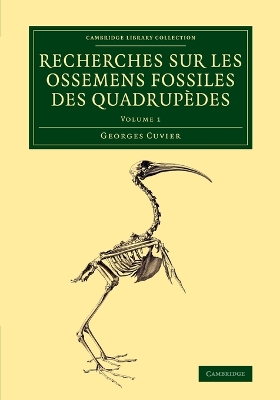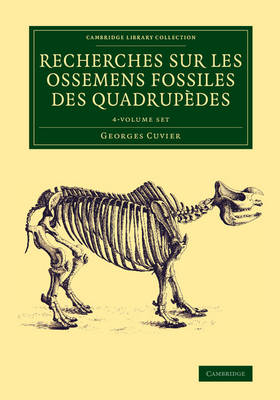Cambridge Library Collection - Earth Science
1 primary work • 6 total works
Volume 4
Georges Cuvier (1769–1832), one of the founding figures of vertebrate palaeontology, pursued a successful scientific career despite the political upheavals in France during his lifetime. In the 1790s, Cuvier's work on fossils of large mammals including mammoths enabled him to show that extinction was a scientific fact. In 1812 Cuvier published this collection of his geological and osteological papers, focusing on living and extinct pachyderms, ruminants, horses and pigs. Volume 1 begins with a substantial essay on human origins and the formation of the earth, which was translated into English by Robert Kerr in 1813 (also available). It also includes an essay on the Egyptian ibis mummy brought back from Napoleon's campaign in Egypt, and an updated version of Cuvier's influential 1810 geological description of the Paris basin, co-authored with Alexandre Brogniart (1770–1847), which helped establish the principle of faunal succession in rock strata of different ages.
Recherches sur les ossemens fossiles des quadrupedes 4 Volume Set
by Georges Cuvier
Published 12 March 2015
Georges Cuvier (1769-1832), one of the founding figures of vertebrate palaeontology, pursued a successful scientific career despite the political upheavals in France during his lifetime. In the 1790s, Cuvier's work on fossil mammoths enabled him to recognise that these were a different species from modern elephants, and that extinction was a scientific fact. He went on to show that many other large mammals had also become extinct. This four-volume work, originally published in 1812, is a collection of Cuvier's geological and osteological papers, focusing on fossil mammals including mastodon, rhinoceros, hippopotamus, ruminants, horses and pigs, and related living species. The introductory essay considers human origins and the formation of the earth, and appeared in English translation in 1813 (also available). Cuvier went on to publish his famous Le regne animal, available in the Cambridge Library Collection both in French (1817) and in Edward Griffith's expanded English translation (1827-35).
Recherches sur les ossemens fossiles des quadrupèdes: Volume 2
by Georges Cuvier
Published 5 June 2015
Georges Cuvier (1769–1832), one of the founding figures of vertebrate palaeontology, pursued a successful scientific career despite the political upheavals in France during his lifetime. In the 1790s, Cuvier's work on fossils of large mammals including mammoths enabled him to show that extinction was a scientific fact. In 1812 Cuvier published this four-volume illustrated collection of his papers on palaeontology, osteology and stratigraphy. It was followed in 1817 by his famous Le règne animal, available in the Cambridge Library Collection both in French and in Edward Griffith's expanded English translation (1827–35). Volume 2 of Recherches sur les ossemens fossiles describes eleven species of pachyderm found in recent alluvial deposits. They include elephants, mastodons, rhinoceros, hippopotamus, tapir and the hyrax (which Cuvier classified as an ungulate rather than a rodent). Cuvier argued from osteological comparisons with living species that all should be considered distinct species in their own right.
Recherches sur les ossemens fossiles des quadrupèdes: Volume 3
by Georges Cuvier
Published 5 June 2015
Georges Cuvier (1769–1832), one of the founding figures of vertebrate palaeontology, pursued a successful scientific career despite the political upheavals in France during his lifetime. In the 1790s, Cuvier's work on fossils of large mammals including mammoths enabled him to show that extinction was a scientific fact. In 1812 Cuvier published this four-volume illustrated collection of his papers on palaeontology, osteology (notably dentition) and stratigraphy. It was followed in 1817 by his famous Le règne animal, available in the Cambridge Library Collection both in French and in Edward Griffith's expanded English translation (1827–35). Volume 3 of Recherches sur les ossemens fossiles recounts Cuvier's excitement at acquiring fossils from gypsum quarries near Paris, and the challenges of piecing the fragments together correctly. Cuvier describes the methodical reconstruction of the pachyderm fossils and lists other fossils occurring in the same rock formations: carnivores, an opossum, birds, reptiles, and fish.
Recherches sur les ossemens fossiles des quadrupèdes: Volume 1
by Georges Cuvier
Published 5 June 2015
Georges Cuvier (1769–1832), one of the founding figures of vertebrate palaeontology, pursued a successful scientific career despite the political upheavals in France during his lifetime. In the 1790s, Cuvier's work on fossils of large mammals including mammoths enabled him to show that extinction was a scientific fact. In 1812 Cuvier published this collection of his geological and osteological papers, focusing on living and extinct pachyderms, ruminants, horses and pigs. Volume 1 begins with a substantial essay on human origins and the formation of the earth, which was translated into English by Robert Kerr in 1813 (also available). It also includes an essay on the Egyptian ibis mummy brought back from Napoleon's campaign in Egypt, and an updated version of Cuvier's influential 1810 geological description of the Paris basin, co-authored with Alexandre Brogniart (1770–1847), which helped establish the principle of faunal succession in rock strata of different ages.
Recherches sur les ossemens fossiles des quadrupèdes: Volume 4
by Georges Cuvier
Published 5 June 2015
Georges Cuvier (1769–1832), one of the founding figures of vertebrate palaeontology, pursued a successful scientific career despite the political upheavals in France during his lifetime. In the 1790s, Cuvier's work on fossils of large mammals including mammoths enabled him to show that extinction was a scientific fact. In 1812 Cuvier published this four-volume illustrated collection of his papers on palaeontology, osteology (notably dentition) and stratigraphy. It was followed in 1817 by his famous Le règne animal, available in the Cambridge Library Collection both in French and in Edward Griffith's expanded English translation (1827–35). Volume 4 of Recherches sur les ossemens fossiles focuses first on ruminants, horses and pigs. Cuvier then discusses fossils of carnivores, including bears, hyenas and big cats. The book concludes by describing fossil sloths, and the oviparous reptiles found in older strata, such as crocodiles, turtles, and marine dinosaurs.


